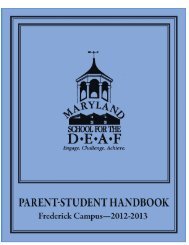You also want an ePaper? Increase the reach of your titles
YUMPU automatically turns print PDFs into web optimized ePapers that Google loves.
always remembered “Scrooge”. It wasn’t until he was at Gallaudet<br />
one cold winter evening that he came across Dickens’ “Christmas<br />
Stories” in <strong>the</strong> library and thumbing through it came across<br />
that name – Scrooge! It was like finding a long lost friend. He<br />
took it back to his room and read it straight through, laughing<br />
and crying by turns. As <strong>the</strong> building heat was turned way down<br />
at night, he had to read in his overcoat!<br />
In Colorado, George had become deeply interested in poultry,<br />
eventually having one of <strong>the</strong> largest pigeon and poultry concerns<br />
in <strong>the</strong> state. He was a member and officer of many poultry<br />
associations and served as editor <strong>for</strong> many of <strong>the</strong>ir magazines.<br />
He became very well known <strong>for</strong> his skill in growing dahlias as<br />
well as peonies, irises and gladioluses, many times sending bulbs<br />
back to <strong>the</strong> <strong>Maryland</strong> <strong>School</strong> <strong>for</strong> <strong>the</strong> gardens <strong>the</strong>re. In 1894<br />
he married Mary Elizabeth Bigler. George wrote about <strong>the</strong>ir<br />
two small dogs, Pegeen Mike and Araminata, as well as <strong>the</strong>ir<br />
cat. The cat was detailed to wake Mrs. Veditz in <strong>the</strong> morning<br />
once George had prepared breakfast. The children in <strong>the</strong> area<br />
knew <strong>the</strong> dogs as “The two little, white dogs that belong to <strong>the</strong><br />
red-headed deaf man who owns all those chickens and pigeons.”<br />
He continued his association with his old school and <strong>for</strong> fifteen<br />
years, 1884-1899, served as chairman of <strong>the</strong> annual reunion<br />
and summer picnic <strong>for</strong> <strong>Maryland</strong>’s deaf citizens.<br />
George was <strong>the</strong> alternate speaker <strong>for</strong> <strong>the</strong> dedication of <strong>the</strong><br />
Gallaudet Memorial at <strong>the</strong> college in 1889 and at that time<br />
founded <strong>the</strong> Alumni Association of <strong>the</strong> College sending out<br />
a call <strong>for</strong> <strong>the</strong> first meeting.<br />
He founded <strong>the</strong> <strong>Maryland</strong> Association of <strong>the</strong> <strong>Deaf</strong> in 1892<br />
and served as its President until 1897. In 1904 he founded <strong>the</strong><br />
Colorado Association.<br />
But it is in <strong>the</strong> area of serving as an advocate <strong>for</strong> <strong>the</strong> deaf<br />
and preservation of sign language that he is best loved and<br />
remembered, though he was many times accused of “biting<br />
sarcasm” in holding true to fighting <strong>for</strong> <strong>the</strong> things he believed<br />
in and facing issues squarely. George could be a staunch friend,<br />
but with <strong>the</strong> power of his pen could also be a most <strong>for</strong>midable<br />
adversary!<br />
In 1904 at St. Louis he was elected President of <strong>the</strong><br />
National Association and World’s Congress of <strong>the</strong> <strong>Deaf</strong> and<br />
was elected to a second term as President of <strong>the</strong> Association<br />
in 1907. Immediately at <strong>the</strong> beginning of this second term<br />
through his position as editor of <strong>the</strong> <strong>Deaf</strong> American he called<br />
attention to a pressing problem. The deaf could not apply <strong>for</strong><br />
positions with <strong>the</strong> Civil Service being <strong>the</strong>n unfairly categorized<br />
with <strong>the</strong> “criminal and insane” under <strong>the</strong>ir regulations<br />
and, <strong>the</strong>re<strong>for</strong>e, prevented any opportunity <strong>for</strong> government<br />
employment. George began a rigorous campaign against this<br />
discrimination.<br />
It happened that during <strong>the</strong> 1908 presidential election<br />
both candidates, William Howard Taft and William Jennings<br />
Bryan, were favorable to George’s position regarding this discrimination,<br />
but it was important to back <strong>the</strong> one who would<br />
win! He decided upon Taft and threw his influence and weight,<br />
THE MARYLAND BULLETIN, FALL <strong>2008</strong><br />
MSD Flashback<br />
and that of <strong>the</strong> <strong>Deaf</strong> American, behind this candidate. For <strong>the</strong><br />
first time American deaf were solidly behind an important issue<br />
during a presidential campaign. Meanwhile <strong>the</strong>n President<br />
Roosevelt had issued an executive order which removed this<br />
categorization of <strong>the</strong> deaf with <strong>the</strong> Civil Service, but it wasn’t<br />
until 1911 that President Taft had <strong>the</strong> heads of federal government<br />
departments actively select positions where hearing was<br />
not necessary <strong>for</strong> employment and <strong>for</strong> which deaf people could<br />
now apply. George, <strong>the</strong> <strong>Deaf</strong> American, and more importantly<br />
America’s deaf citizens had won <strong>the</strong> day!<br />
Later in 1913 George had a personal interview with<br />
President Wilson and was <strong>the</strong> first American deaf man to so<br />
meet a president, returning with a handwritten promise from<br />
Mr. Wilson to do “all he could to help <strong>the</strong> deaf.”<br />
He would originate <strong>the</strong> moving picture fund of sign language<br />
of <strong>the</strong> National Association of <strong>the</strong> <strong>Deaf</strong> and some of <strong>the</strong>se films<br />
are now priceless and <strong>the</strong> language in <strong>the</strong>m would not have been<br />
preserved had it not been <strong>for</strong> George’s <strong>for</strong>esight. In <strong>the</strong> area of<br />
education of <strong>the</strong> deaf, George stated he had, “…always been an<br />
uncompromising opponent of <strong>the</strong> pure oral method.”<br />
With all of his many activities and interests he still found<br />
time to be a very competent chess player and in 1915 was <strong>the</strong><br />
only Colorado Springs player in a tournament to defeat <strong>the</strong><br />
<strong>the</strong>n United States chess champion.<br />
In <strong>the</strong> late 1920s he corresponded with Thomas A. Edison<br />
regarding <strong>the</strong> television. George was very interested in <strong>the</strong><br />
television feeling it would offer to <strong>the</strong> deaf visually <strong>the</strong> same<br />
advantages that <strong>the</strong> phone did to <strong>the</strong> hearing. Mr. Edison<br />
stated in a March 1928 letter he thought television would be<br />
somewhat perfected, but he could not see any particular value<br />
in <strong>the</strong> commercial sense!<br />
This wonderful, versatile individual, George W. Veditz,<br />
passed away at his Colorado Springs home on March 12 th , 1937.<br />
Immediately tributes poured in from all over <strong>the</strong> country –<br />
“…most valiant fighter in <strong>the</strong> cause of <strong>the</strong> deaf…”<br />
“He never knew <strong>the</strong> word ‘ defeat’, because<br />
he refused to acknowledge it...”<br />
“Veditz was a natural-born fighter. He<br />
would ra<strong>the</strong>r fight than eat.”<br />
“There was no worthy cause of <strong>the</strong> deaf but<br />
found him its vigorous champion…”<br />
His memory is kept alive at <strong>the</strong> <strong>Maryland</strong> <strong>School</strong> <strong>for</strong> <strong>the</strong><br />
<strong>Deaf</strong> through <strong>the</strong> Veditz Vocational Building and his portrait<br />
by MSD alumnus, Louis Frisino, is on display in <strong>the</strong> school’s<br />
Bjorlee Museum. MB<br />
—Linda Stull, Administrative<br />
Assistant, Linda.stull@msd.edu<br />
(Ms. Stull is indebted to <strong>the</strong> writings of Mr. George Veditz as well<br />
as those of Dr. Ignatius Bjorlee <strong>for</strong> <strong>the</strong> material in this article.)<br />
31






